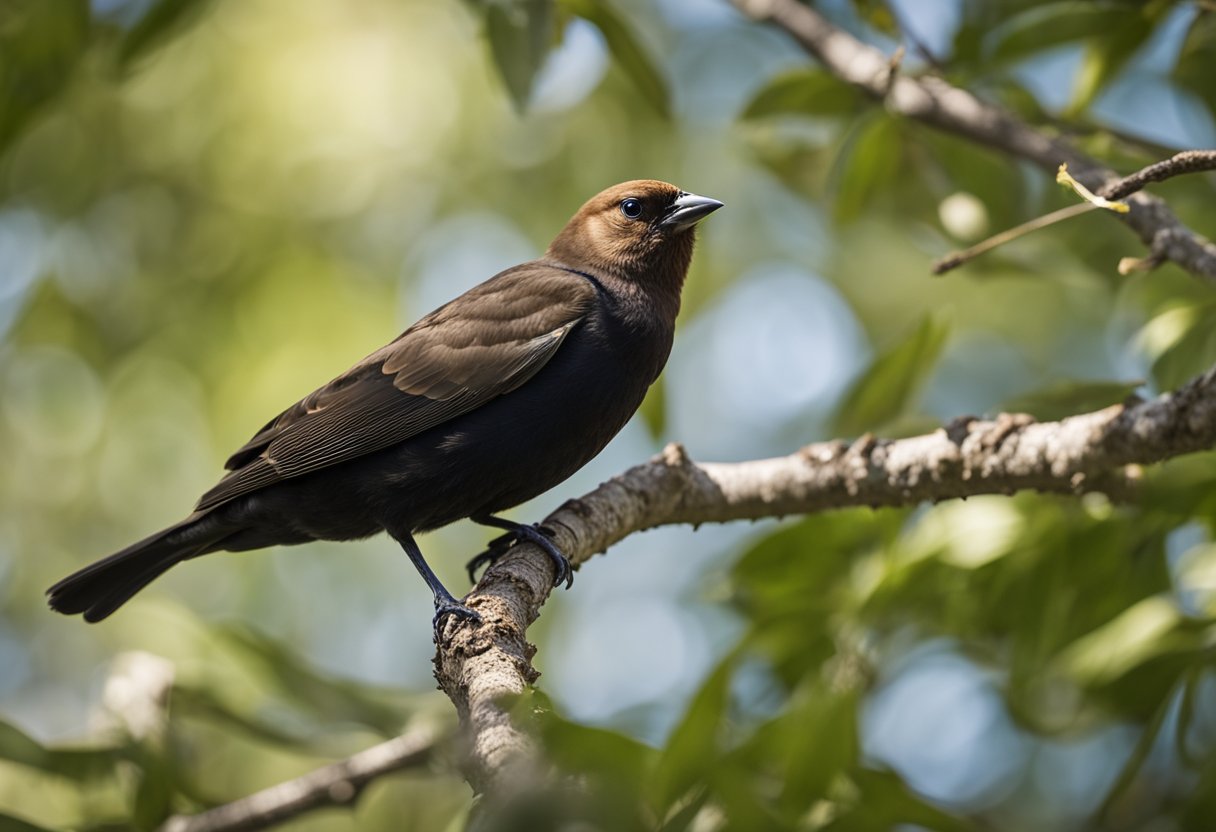Overview and Identification
The Brown-headed Cowbird, scientifically named Molothrus ater, is known for its distinct physical traits and vocalizations. Identifying this species involves recognizing its unique plumage and understanding its calls.
Physical Characteristics
The male Brown-headed Cowbird features an unmistakable glossy black body complemented by a rich brown head. This striking contrast makes them relatively easy to identify among other birds. Females, on the other hand, display a more subdued appearance with a streaky brown plumage, which helps them blend into their environments.
A typical adult male measures about 7.5 to 8.5 inches in length with a wingspan of around 12 to 13 inches. The female is slightly smaller, aiding in inherent differences between genders. These birds lack the bright colors typical of many songbirds, which contributes to their more understated appearance in the wild.
Vocalizations and Sounds
The vocalizations of the Brown-headed Cowbird are distinctive and vary across different contexts. Males produce a series of sharp notes and whistles, often heard during the breeding season. Their song can be described as a series of low-pitched “chick” sounds, which helps establish territory and attract mates.
Females primarily use a soft “chatter” call, especially while foraging or in the presence of potential threats. Both sexes communicate through a variety of sounds, contributing to their social behavior. Their vocalizations play a crucial role in their mating rituals and are critical for social interactions among flocks.
Habitat and Behavior

The Brown-headed Cowbird inhabits diverse environments across North America. Its adaptability to various habitats significantly influences its behavior, including feeding and migratory patterns.
Adaptation and Distribution
Brown-headed Cowbirds are primarily found in open country, including grasslands, fields, prairies, and edges of forests. They are often seen in areas with livestock such as cattle and bison, which inadvertently create foraging opportunities by disturbing the soil. Their distribution extends from Canada and Alaska in the north down to the southeastern United States. This bird thrives in diverse ecosystems, from farmland to desert regions, enabling it to adapt to changing environments.
Diet and Feeding Patterns
The diet of the Brown-headed Cowbird consists mainly of seeds and insects. They are opportunistic feeders, often foraging in flocks, particularly in areas where livestock are present. Cowbirds take advantage of disturbed soil to find insects and seeds more easily. They are also common at bird feeders, where they will consume a variety of seeds. The ability to forage effectively in both wild and human-altered landscapes contributes to their success as a species.
Migratory Patterns
Brown-headed Cowbirds exhibit migratory behavior, typically traveling in flocks during migration periods. They breed in the northern regions, including Canada and the northern United States. In the fall, they migrate south, reaching as far as the southern United States and northern Mexico. Their migratory routes vary, and they can often be seen in open areas and farmlands as they move to wintering grounds. During migration, they rely on available food sources, adjusting their route based on habitat changes and food availability.
Reproduction and Brood Parasitism
The Brown-headed Cowbird employs a unique reproductive strategy that relies on other birds to raise its young. This section examines the implications of brood parasitism on host species and explores conservation efforts addressing this behavior.
The Parasitic Breeding Strategy
Brown-headed Cowbirds are known as brood parasites. Females seek out nests built by other birds, such as sparrows, robins, and warblers, laying one to several eggs in each. Cowbird eggs often mimic the appearance of host eggs, making them less identifiable to the host.
The breeding season occurs from early spring to late summer. A single cowbird female can lay eggs in multiple nests, leading to varied survival rates among host chicks. Cowbird nestlings tend to hatch earlier and grow faster than their foster siblings, giving them a competitive edge for food and resources.
Effects on Host Species
Brood parasitism significantly impacts host species. Many native songbirds may unknowingly raise cowbird chicks, which can lead to the decline of their populations. For example, species like the Kirtland’s Warbler and Yellow Warbler experience population pressures from cowbird chicks outcompeting their own nestlings.
The presence of cowbirds can also alter breeding behaviors. Parents may abandon their nests upon discovering cowbird eggs, resulting in lower reproductive success for the host species. Diverse factors, such as habitat loss and increased cowbird populations, exacerbate these effects, threatening native species diversity.
Conservation and Management
Efforts to manage the impact of Brown-headed Cowbirds focus on protecting vulnerable host species. Conservationists often implement measures such as cowbird trapping to reduce their populations in critical areas.
Additionally, creating and preserving habitats suitable for endangered species like the Kirtland’s Warbler is essential. Education on the effects of brood parasitism can also raise public awareness concerning native species and their reproductive challenges.
By understanding the dynamics of brood parasitism, stakeholders can develop strategies to support affected songbirds while ensuring the balance of ecosystem interactions.
Share this content:

Post Comment
You must be logged in to post a comment.